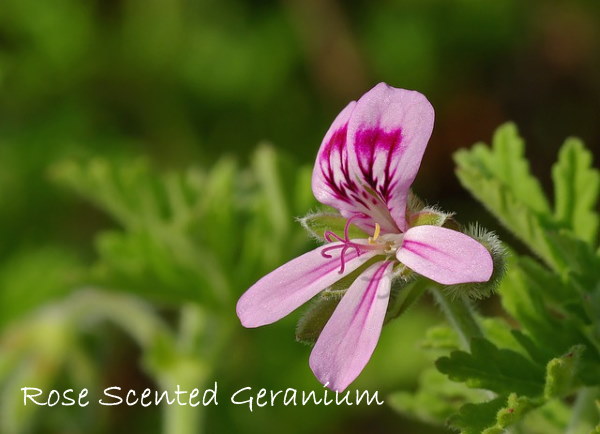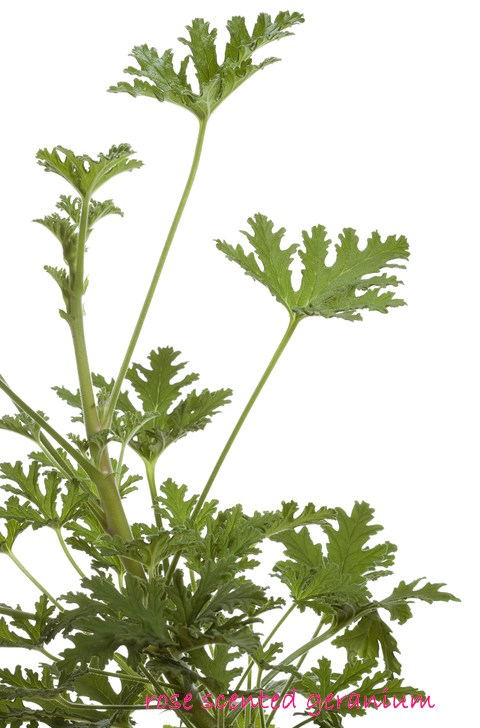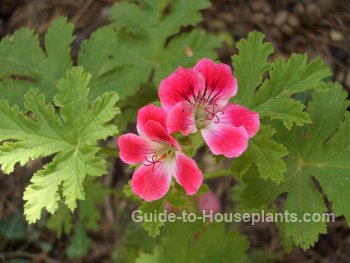Scented Geranium Plant Care
Botanical Name: Pelargonium spp.
Many types of geraniums are prized. But scented geranium species offer intensely fragrant leaves. Just a brush of your hand across the foliage of these scented-leaf geraniums will give off a delightful fragrance in a spectacular choice of scents.
 Pelargonium graveolens is a favorite for its beautiful rose fragrance. Image by WikiImages
Pelargonium graveolens is a favorite for its beautiful rose fragrance. Image by WikiImagesGet to Know Scented Geraniums
Known botanically as Pelargoniums, this genus includes many species native to South Africa.
How big do they get? Scented geraniums will reach a mature height of 12-18 in (30-45 cm), depending on the variety and growing conditions.
Rose scented geranium plants (Pelargonium capitatum) have foliage so fragrant that their small, pink flowers are merely an added attraction. Another rose geranium is Pelargonium graveolens, a large, vigorous plant with deeply lobed, finely cut leaves. Lemon geranium (Pelargonium crispum) is especially aromatic -- even the slightest touch of its leaves releases a fresh, citrusy scent into the air.
Apple geranium (Pelargonium odoratissimum) has a delightful apple aroma with a hint of cinnamon. Wonderfully fragrant strawberry geranium (P. x scarboroviae) features a compact growing habit. Peppermint geranium (P. tomentosum) has a trailing habit with big, velvety leaves.
 Beautifully fragrant leaves of rose-scented geranium. Photo: AYImages / istockphoto
Beautifully fragrant leaves of rose-scented geranium. Photo: AYImages / istockphotoYou can buy geraniums in garden centers and online in spring and summer.
Scented geraniums are typically light bloomers, so choose one based on the scent you like.
Citrus-scented geraniums have smaller leaves and compact growth, making them ideal for growing indoors on a sunny windowsill. Pelargonium crispum 'Peach Cream' has pink flowers and a peach aroma.
Rose scented geranium plants (P. graveolens), shown above, have intricately patterned leaves that look like snowflakes and a beautiful rose fragrance. It is a vigorous variety that should be pinched back often to prevent it from getting leggy.
Year-Round Care for Scented Geraniums
Pinch your plant. Pinch off stems regularly to encourage branching and to maintain an attractive shape. Don't toss those cuttings either -- they can be rooted to give you new plants. Also, remove spent flowers to keep your plant looking neat and to promote more blooms.
Repot in spring. Geraniums bloom best if slightly pot-bound. Move your plant to a pot 1 size larger or keep it in the same pot and just give it fresh soil. Use a pot with a drainage hole to prevent soggy potting medium. Get tips for repotting here.
Overwinter care. Most scented geranium plants never go dormant. You can keep your geranium in bright light year-round. Water less in winter because the growth has slowed, but don't allow soil to dry out completely. If you want to give your plant a rest in winter, you can keep it in a cool basement or garage with a minimum temperature of 50°F/10°C. During this rest, water sparingly.
Scented Geranium Plant Care Tips

Light: Bright light to full sun. Give your scented geranium as much light as you can spring through fall. Move it outdoors for the summer, if you like. Just bring it back indoors when the temperature drops below 50°F/10°C. This is a tender perennial that doesn't like the cold.
Water: Water thoroughly, until water runs out of the drainage hole, then empty the saucer. Don't water again until the top couple inches of soil is dry. Cut back on watering in winter, but don't allow the roots to dry out completely.
Humidity: This plant will tolerate average indoor humidity (around 40%). If air is dry, use one of these easy ways to increase humidity for your houseplants.
Temperature: Cool nights (55-60°F/13-16°C) and warm days (65-75°F/18-24°C) will trigger flower buds.
Soil: Peat-based soilless mix
Fertilizer: Feed every 3 weeks spring through fall with a high-phosphorus liquid fertilizer diluted by half.
Propagation: Take stem cuttings in spring and early summer to start new plants. Dip cut end in rooting hormone powder, then insert in fresh potting mix. Keep cuttings moist, but not soggy. Keep the cuttings in bright, indirect sunlight until roots are formed, then move them into full sunlight. Pelargoniums are easy to grow from seeds, too. Start seeds in December for mature plants the following spring and summer.


